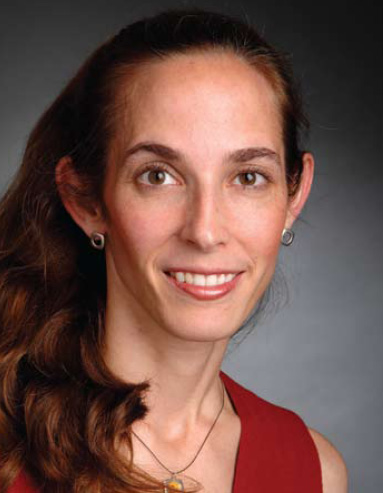For some, this is a question answered with conviction in childhood. For others, it is a journey peppered with path-altering interjections. For me, one such career-altering influence was the ASH Fellow Scholar Award in Clinical Translational Research.
From a relatively young age, I contemplated two dichotomous paths — that of a physician or ballerina. At Duke University I completed the necessary pre-medical requirements and thought I would become a general pediatrician. A research career was not in my range of sight with no scientists in my family and no prior laboratory-based research experience. The earliest seed of change was planted when I applied to medical school. One of my interviewers was David Sabiston, then the chief of surgery at Duke University Medical Center. After the interview, he called me to follow up on our discussions and urged me to consider a physician-scientist career. I was shocked by his genuine interest in my career and intrigued by his suggestion.
As a student at Harvard Medical School, I found myself drawn to the field of hematology-oncology and, with the seed planted three years prior, embarked on a Howard Hughes Medical Institute (HHMI) Medical Student Research Fellowship. It was a year like no other. I worked in the laboratory of Dr. Gary Gilliland and managed to continue to pursue my passion for ballet, dancing with Ballet Theatre of Boston. I was mentored at the bench by Dr. Todd Golub, then a pediatric hematology-oncology postdoctoral fellow. Dr. Golub had recently cloned the ETV6 (TEL) gene in a TEL-PDGFRβ rearrangement in CMML. What then followed was his cloning of leukemia-related TEL-ABL and TEL-AML1 rearrangements and our discovery of frequent TEL abnormalities in children with ALL. I was hooked. When I was searching for laboratories, one of the medical students working in Dr. Gilliland’s laboratory raved about his mentoring and the overall laboratory environment. She was most certainly correct. I could not have asked for a more outstanding environment in which to learn. This year was transformative. I often wonder where I would be today if it were not for the magic of that first year in the laboratory.
After completing a pediatric residency at the Children’s Hospital Boston and the first year of a pediatric hematology-oncology fellowship at the Dana-Farber Cancer Institute and Children’s Hospital, I faced the challenge of selecting a laboratory. I gravitated toward Dr. Golub and the promise of genomics for cancer-related discovery. Since my training in Dr. Gilliland’s laboratory, Dr. Golub had become a principal investigator at Dana-Farber and the director of the cancer program at the Broad Institute of Harvard and MIT. During my postdoctoral training, we developed an approach to small-molecule discovery using gene expression signatures and applied it to the identification of chemical modulators of AML differentiation. At this point, the idea of a physician-scientist career continued to be affirmed. However, the leap from postdoctoral fellow to independent investigator seemed to span a deep ravine.
What inspired the vault despite the possible plunge? For me, a critical issue was truly remarkable mentoring from both Drs. Gilliland and Golub. To this day, they continue as my two primary career mentors, even as my network of mentors has grown. A second was the outstanding support that I received at Dana-Farber Cancer Institute, Children’s Hospital Boston, and the Broad Institute, where numerous individuals encouraged my efforts and guided my path toward a physician-scientist career. A third was the external validation that I could succeed in this path.
The ASH Fellow Scholar Award in Clinical Translational Research came at just the right time. This award was pivotal in my career transition. It affirmed, by an external group of senior scientists, a confidence in my ability to succeed in this path and welcomed me into the greater community of ASH. It funded some of the earliest efforts in my laboratory to develop gene-expression-based high-throughput screening and its application to leukemia. This work was recognized with the ASH Joanne Levy, MD, Memorial Award. (Joanne Levy was also an ASH Scholar Award recipient.) This award was an incredible honor and inspiration to continue my studies.
I currently lead a laboratory-based research effort at the Dana-Farber Cancer Institute and am an associate member of the Broad Institute. My research focuses on the integration of new genomic approaches for both target and small-molecule discovery for the acute leukemias and other malignancies affecting children. I also provide clinical care to children with cancer at Dana-Farber and Children’s Hospital Boston. ASH is an ongoing lifeline for my work. It is a rich source of mentors and collaborators. I have also enjoyed the opportunity to develop ASH-related educational materials, to serve on abstract review and scientific committees, and to both chair sessions and share our work at the annual meeting.
One of the great joys of a physician-scientist career is the mentoring of trainees. As I develop my research program, I now have the pleasure of sharing in the excitement of my students and postdoctoral fellows as they win ASH-related training awards and present their work at the annual meeting. As a nucleus for fomenting collaboration, encouraging innovative science, connecting student with mentor, and empowering early investigators, ASH is a critical force in the future of hematology research.
Drs. Gary Gilliland and Todd Golub, Dr. Stegmaier’s mentors, are also past ASH Scholar Award recipients. This program has had obvious impact on hundreds of careers. ASH is a 501(c) (3) charitable and educational organization. The Society seeks annual donations for several programs, one of which is the ASH Scholar Awards. If you would like to contribute to the ASH Scholar Awards program to support the next generation of promising hematology researchers, please visit www.hematology.organd click on “Make a Gift.” If you have donation questions, please e-mail development@hematology.org.

